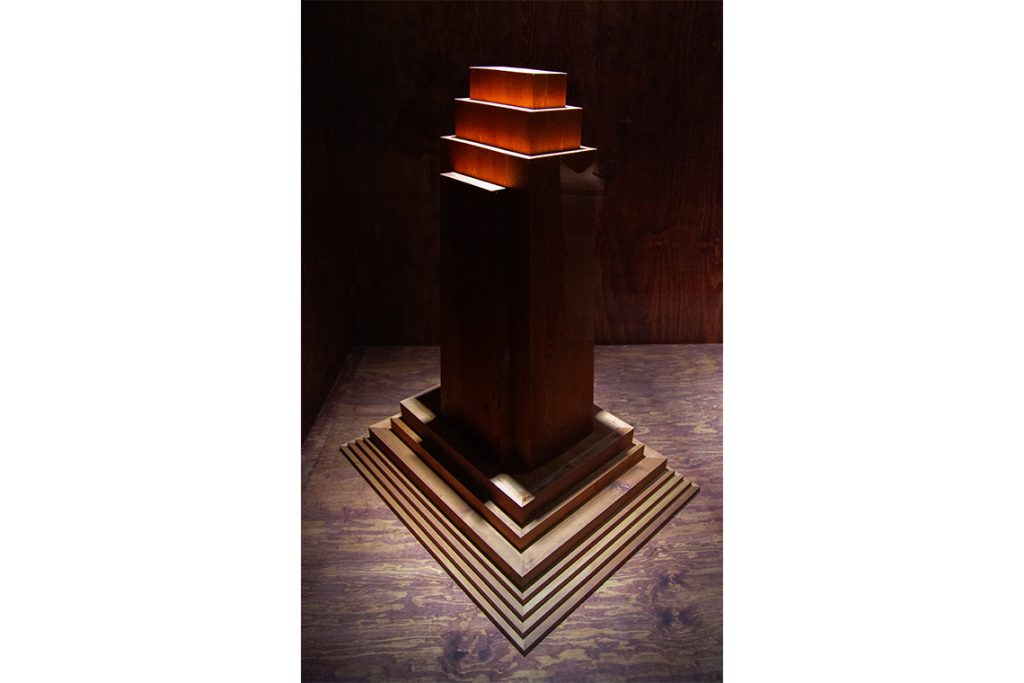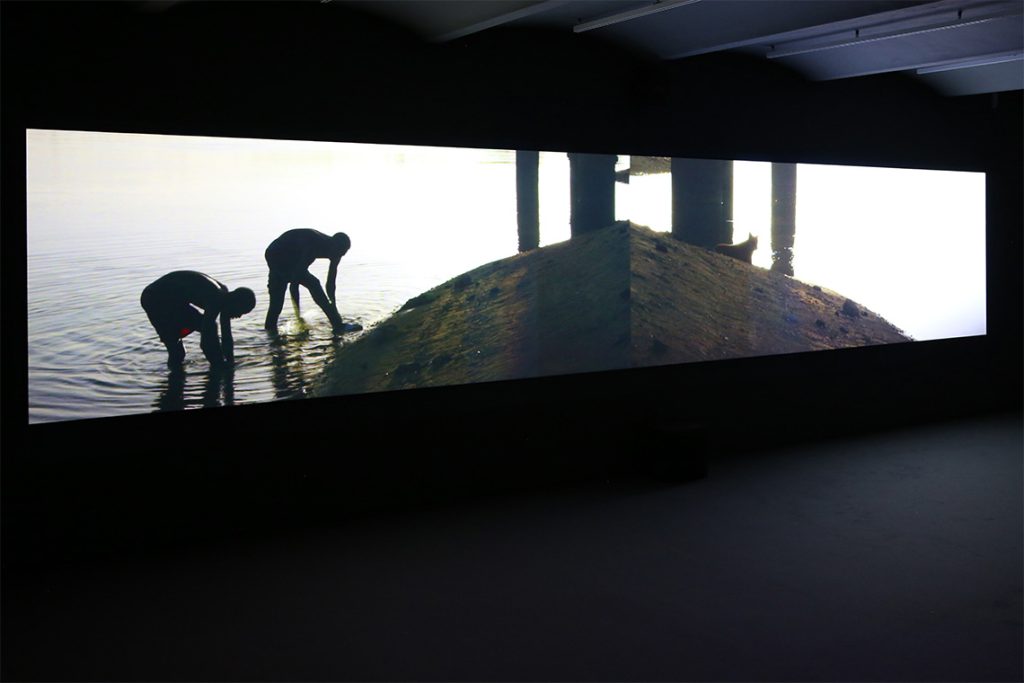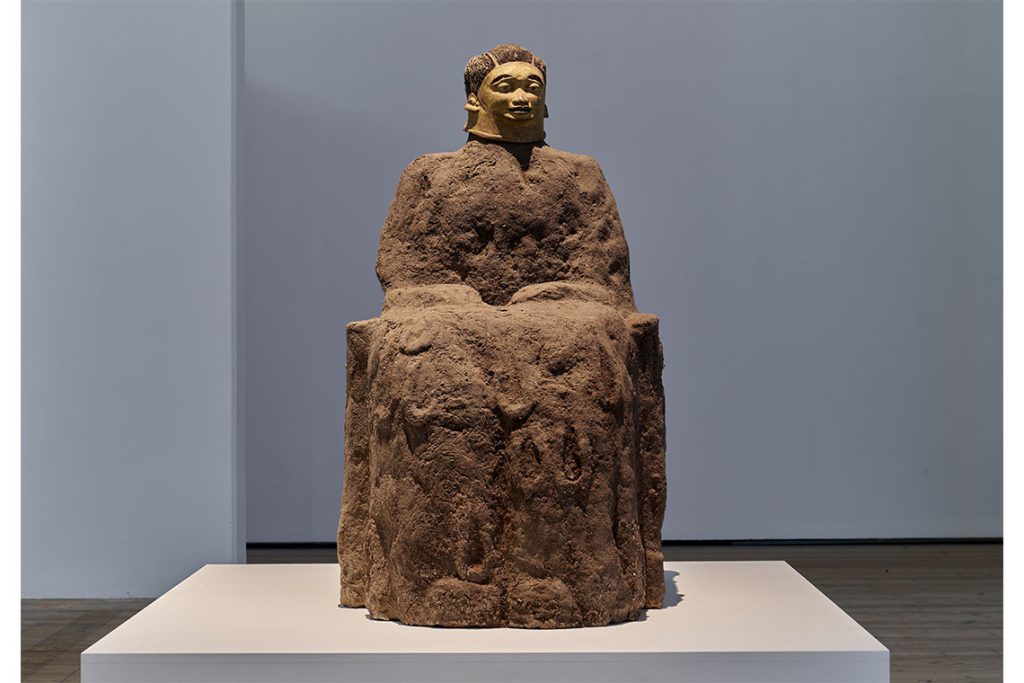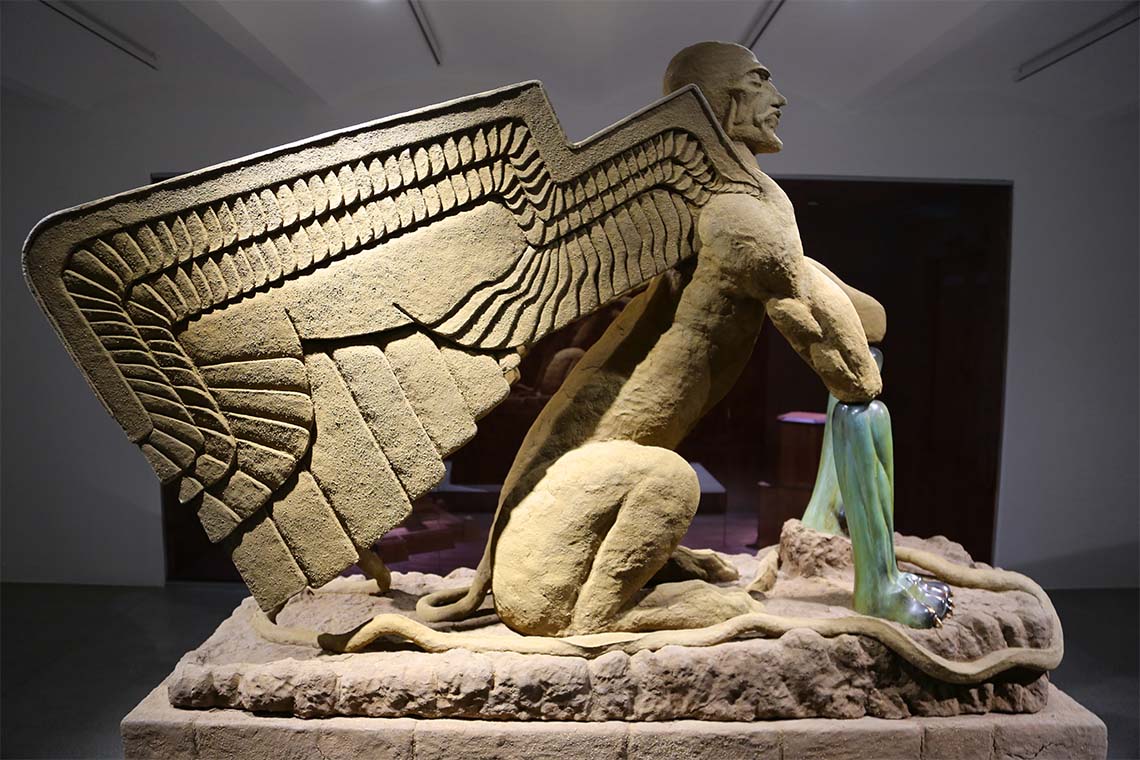Recasting the heroic monument as a site of vulnerability, Ali Cherri builds an alternative archive from broken things, mud and malleable myth.
Entering How I Am Monument, the first major UK institutional solo show by Lebanese artist Ali Cherri at Baltic Centre for Contemporary Art, is like stepping into a post-apocalyptic museum – or perhaps a premonitory one. The soft pink glow of the spotlights, the dust-saturated slide projections and the mud-caked limbs of Cherri’s hybrid figures together conjure a space between ruin and genesis. This is not an exhibition that delivers answers. Instead, it offers artefacts of survival, evocations of power’s fragility and a material-based meditation on the narratives that we enshrine through history, sculpture and soil.
Cherri, born in Beirut during the Lebanese Civil War, speaks of mud not merely as muck, but as foundational matter: “Mud is this coming together of earth and water, it makes everything possible,” he says in the exhibition’s introductory video. Throughout How I Am Monument, mud is creation, destruction, transformation – ground zero for both myth and memory. In the three-channel film installation Of Men and Gods and Mud (2022), awarded the Silver Lion at the Venice Biennale, brickmakers toil beside Sudan’s Merowe Dam, carving their livelihood – quite literally – from the earth. We are told in voiceover, “The story of the flood as world-maker is in fact the story of mud”. The film connects the everyday, mundane rhythm of brickmaking with the mythic, such as the Epic of Gilgamesh: it is in the mud that memory, myth and meaning are formed. Like the mud bricks, even the mythic and monumental is nonetheless mutable, shaped by many hands and susceptible to erosion or reinterpretation.

Photography by Ali Cherri Studio. Image courtesy of the artist and Imane Farès, Paris
This dynamic tension between fragility and permanence is crystallised in Sphinx (2024), a centrepiece of the exhibition. The hybrid creature, part-human and part-beast, recalls the grandeur of Assyrian lamassu or Egyptian sphinxes. But unlike their eternal stone or metal counterparts, this figure’s torso is sculpted from mud – precarious, porous and visibly eroding. Its front limbs, however, are cast in gleaming bronze, a material traditionally reserved for immortalising heroes and sovereigns. Cherri’s use of bronze here is not about stability but imbalance: the sculpture quite literally leans on it, with its muddy form propped up by prosthetic limbs. A long cartoonish serpent coils around the plinth, peering curiously out at viewers. It’s a visual and material contradiction that destabilises the language of classical monuments, suggesting that power – like the materials that represent it – is more vulnerable than it appears.
In this way, Cherri subverts the very idea of a monument. Often constructed from materials intended to last forever, such as bronze and stone, monuments enshrine and solidify narratives of power. His approach, however, uses mud to craft a different kind of monument, one that resists finality. His Toppled Monuments 1–6 (2024), too, undermine the desired permanence of monuments. Displayed in vitrines echoing colonial museology, these are wooden sculptures representing the empty plinths of removed statues from places including Kharkiv, Aleppo, Richmond (Virginia, USA), and Bristol. They ask us not to remember the individuals once elevated there, but to confront the space left behind and what we choose to fill it with: an invitation to re-evaluate our past and imagine future possibilities. These are monuments not to heroes, but to absence and potential – to the social and political voids where new stories could be told.

Photography by Ali Cherri Studio. Image courtesy of the artist and Imane Farès, Paris
Narratives of survival and rebirth – bodily, cultural and ecological – run throughout the exhibition. In his Graftings series, fragmented objects from antique markets (including a Mapico mask from Tanzania in Seated Figure (2022) and a Mayan cult vase in Titan 2 (2022) are fused with mud to form chimeric bodies. “I look at it really as a form of solidarity between broken objects,” Cherri explains. “These broken things come together to form a new body, a surviving body.” This grafting echoes botanical and medical practices, but it is also political: a new creature is created from the detritus of history, finding cohesion where once there was rupture.
The ethos of rejecting grand, dominant narratives (like heroic war or linear history) is made flesh in The Watchman (2023), a short film set on the militarised border in Cyprus in which a military figure – typically an emblem of state power – is rendered powerless and passive. The lone Turkish soldier in the watchtower is less a symbol of authority than one of impotence. Reflections in the glass obscure his eyes, a bead of sweat slides down his neck. He is haunted not by conflict, but by waiting – for meaning, for orders, for history to resume. “What does the space of waiting look like?” Cherri asks. In The Watchman, it is a liminal zone where the only ‘attackers’ are a robin that crashes into the watchtower’s glass screen and ghostly soldiers with no eyes, seemingly clad in military gear of eras past – a scene also evoked by Cherri in The Seven Soldiers (2023), a series of oversized heads with their eyes closed. There is “no such thing as a good war,” an elderly woman tells the soldier. Futility echoes loudly, and what remains is merely the drone of cicadas.

Photography by Reece Straw © 2025 Baltic Centre for Contemporary Art
Across the exhibition, the natural world quietly witnesses these human dramas. The prickly pear cactus – used across the Mediterranean to mark territory – features in a series of 13 watercolours. Recently afflicted by a disease that desiccates them from within, these living boundaries collapse under their own weight. “I find it quite telling about the state of borders,” Cherri reflects. It is a subtle, poignant metaphor: just as monuments can fall, so too can the biological markers of sovereignty.
The exhibition’s haunting coda is A Monument to Subtle Rot (2024), a slide-projection installation that slowly reveals fragments of a poetic text by Palestinian writer Karim Kattan. Each click of the Kodak carousel delivers another line of text or grainy photo of toppled statues. The slides are scratched, smudged, and fragile. “I am made myself at long last. A monument,” reads one. The text does not build to a climax but rather crumbles, mirroring the decay of the very monuments it describes.
Throughout How I Am Monument, Cherri wields mud not only as a medium but as a conceptual strategy. Where traditional monuments aim for permanence and certainty, Cherri’s works revel in uncertainty, in becoming, in disintegration. This exhibition asks what kind of city we want to build, what kind of history we want to write and what kind of monuments we want to leave behind. At a time when wars rage from Sudan to Gaza (a fact brought into sharp relief by the death of Cherri’s own parents in the Israeli bombing of Beirut last year) and debates over statues and historical narratives remain fraught, How I Am Monument is not only timely but necessary. It is an excavation site of power, memory and myth. In the mud, Cherri shows us not just the ruins of past empires but also the seeds of something new.



